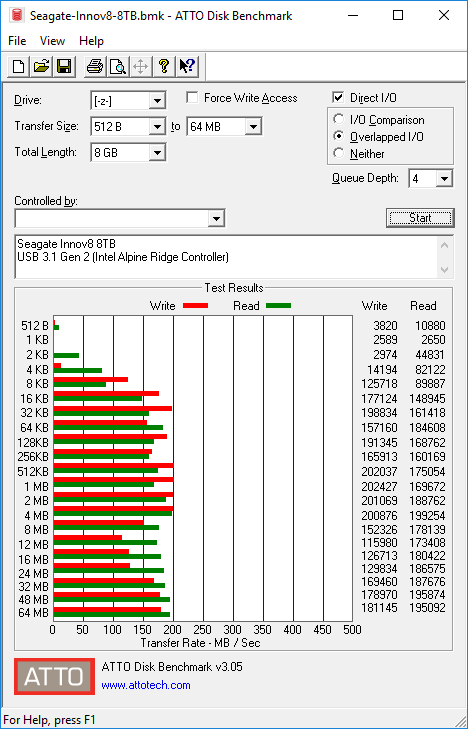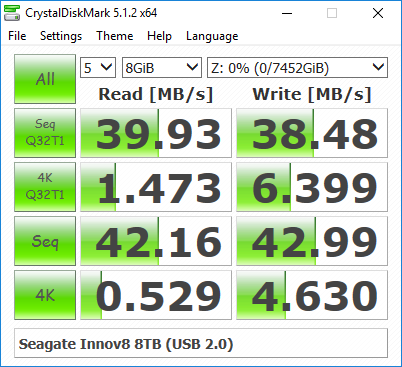Seagate Innov8 8TB Bus-Powered External Hard Drive Review
by Ganesh T S on May 19, 2016 8:30 AM ESTDirect-Attached Storage Benchmarks
The Seagate Innov8 comes pre-formatted in exFAT. We retained the file system along with the contents on it (setup programs for the Seagate Dashboard and a warranty document PDF) for benchmarking purposes. In order to evaluate the DAS aspect of the unit, we utilized the testbed outlined in the table below to test the performance. One of the USB 3.1 ports enabled by the Intel Alpine Ridge controller was used to connect the unit to the system.
| AnandTech DAS Testbed Configuration | |
| Motherboard | GIGABYTE Z170X-UD5 TH ATX |
| CPU | Intel Core i5-6600K |
| Memory | G.Skill Ripjaws 4 F4-2133C15-8GRR 32 GB ( 4x 8GB) DDR4-2133 @ 15-15-15-35 |
| OS Drive | Samsung SM951 MZVPV256 NVMe 256 GB |
| SATA Devices | Corsair Neutron XT SSD 480 GB Intel SSD 730 Series 480 GB |
| Add-on Card | None |
| Chassis | Cooler Master HAF XB EVO |
| PSU | Cooler Master V750 750 W |
| OS | Windows 10 Pro x64 |
| Thanks to Cooler Master, GIGABYTE, G.Skill and Intel for the build components | |
Our testing methodology for DAS units takes into consideration the usual use-case for such devices. The most common usage scenario is transfer of large amounts of photos and videos to and from the unit. The minor usage scenario is importing files directly off the DAS into a multimedia editing program such as Adobe Photoshop. Prior to taking a look at the real-life benchmarks, we first check what ATTO and CrystalDiskMark have to report for the Seagate Innov8. We see numbers around 200 MBps for sequential transfers, correlating well with Seagate's performance claims.
In order to tackle the first real-life use-case, we created three test folders with the following characteristics:
- Photos: 15.6 GB collection of 4320 photos (RAW as well as JPEGs) in 61 sub-folders
- Videos: 16.1 GB collection of 244 videos (MP4 as well as MOVs) in 6 sub-folders
- BR: 10.7 GB Blu-ray folder structure of the IDT Benchmark Blu-ray (the same that we use in our robocopy tests for NAS systems)
| Seagate Innov8 8TB robocopy Benchmarks (MBps) | ||
| Write Bandwidth | Read Bandwidth | |
| Photos | 41.81 | 29.22 |
| Videos | 76.81 | 92.11 |
| Blu-ray Folder | 100.23 | 116.91 |
These numbers show the unpredictable nature of the performance of the drive. It is not only the DRAM cache (that usually delivers predictable changes in performance beyond a certain amount of data), but, also the distributed media cache on the SMR drive that influence the write speeds. Reads are affected quite a bit if they happen to involve data that is currently being subject to 'garbage collection' - i.e, moving from one portion of the drive / cache to a more permanent location in the platters.
For the second use-case, we take advantage of PC Mark 8's storage bench. The storage workload involves games as well as multimedia editing applications. The command line version allows us to cherry-pick storage traces to run on a target drive. We chose the following traces.
- Adobe Photoshop (Light)
- Adobe Photoshop (Heavy)
- Adobe After Effects
- Adobe Illustrator
Usually, PC Mark 8 reports time to complete the trace, but the detailed log report has the read and write bandwidth figures which we present in our performance graphs. Note that the bandwidth number reported in the results don't involve idle time compression. Results might appear low, but that is part of the workload characteristic. This is not the intended use-case for external hard drives, but the results are just presented here for the sake of completeness.
| Seagate Innov8 8TB PCMark8 Storage Benchmarks (MBps) | ||
| Write Bandwidth | Read Bandwidth | |
| Adobe Photoshop (Light) | 73.13 | 3.92 |
| Adobe Photoshop (Heavy) | 94.87 | 5.21 |
| Adobe After Effects | 74.41 | 4.10 |
| Adobe Illustrator | 115.22 | 3.91 |
Seagate explicitly mentions that the Innov8 is not compatible with USB ports delivering less than 7.5W of power. Taking the safe route, they don't advertise compatibility with any Type-A ports. However, we got curious and decided to use a Type-A to Type-C USB 3.1 adapter cable and check with the other USB ports in our DAS testbed.
Surprisingly, even the USB 2.0 ports on the GIGABYTE motherboard in our testbed are able to supply the 7.5W minimum power required by the Innov8.
Our rough benchmarking (CrystalDiskMark only) with the USB 2.0 port shows that sequential transfers have no problems in saturating the USB 2.0 bandwidth.













41 Comments
View All Comments
hlmcompany - Thursday, May 19, 2016 - link
If the lipo does fail at some point, then you RMA the product. If it is out of warranty, then like with any other HDD product, you really have no option. Although, a failed lipo for this device does not necessarily mean you cannot access your data.Gunbuster - Thursday, May 19, 2016 - link
Why not have this use a standard cell like 8650 or CR123A? It would not have been that hard to give it a user accessible battery compartment.DanNeely - Thursday, May 19, 2016 - link
Probably the same reason most phones don't come with replaceable batteries anymore. By the time the battery is dead the remaining hardware would be obsolete. That said, I'd be surprised if someone (probably the night shift of the factory where the OEM batteries are made) doesn't start selling gray market replacements on ebay/etc within a few months.adityarjun - Friday, May 20, 2016 - link
This is an 8TB archive hdd. I would expect it to last for 8-10 years atleast. I have had my current 2TB hdd for 5 years now.This just won't hold up well over time. Once the 2 year warranty expires, anyone who bought this product is going to regret it imho. It really needed to be more modular.
shelbystripes - Thursday, May 19, 2016 - link
This is one of the things that frustrates me about USB in general.To me, this drive is ideal for offsite backup. It has much higher capacity than any other bus-powered drive, and bus-powered drives are ideal because you don't have to worry about keeping track of proprietary AC adapters.
But the wide range of USB power delivery options means we'll keep having devices like this, where it's not clear if I can even use it. The fact that the reviewer got it to work on USB 2.0 ports on one motherboard is great. Some USB ports can deliver well above the minimum spec. But there are USB 3.0 ports that only support the 900mA base spec, and I'm guessing they won't power this thing. And the real problem is, there's no way to tell!
You can't just look at the specs either. My ideal use case is to make offsite backups of my Synology NAS. One 8TB drive would be enough to backup all my critical data, and I could stop using multiple 2.5" drives. But I just spent the last 15 minutes looking through Synology's documentation and they don't publish the power output of their USB ports anywhere. Not online, not in the user manuals, nothing. That doesn't mean the ports can only output 900mA, though, it just means they won't tell me (they tend not to publish the finer details on their SOHO/SMB devices).
The USB power delivery spec is a mess. Even if my devices had a Type-C port, that still wouldn't tell me anything. The minimum requirement for Type-C is still 900mA, the 1.5A mode is optional. You can implement USB 3.0 ("USB 3.1 Gen 1") over Type-C, still only deliver 900mA, and claim USB spec compliance.
Type-C should have come with a 1.5A power delivery requirement. And even then there will be variation on how much more power a device can deliver. USB is getting a lot less universal.
cygnus1 - Thursday, May 19, 2016 - link
I very much agree. I remember with the hype of Type C and USB PD the goal was something like 100W delivered from a Type C host port... I'm guessing the high wattage PD isn't coming anytime soon if these are the kinds of products coming out...hlmcompany - Thursday, May 19, 2016 - link
The spec is there, the technology is there, the implementation lacks because manufactures want to be backward compatible. I wish they would begin to move on and drop the backward compatibility. For a time they could offer two types of products. Although, with the USB connector integrated with the drive's PCBA, they would need to manufacture two different HDD's.CrimsonFury - Friday, May 20, 2016 - link
The 100w power delivery is for power bricks (to standardize USB C for laptop power bricks). It was never intended to provide 100w from a usb port on the PChlmcompany - Friday, May 20, 2016 - link
The intention of PDP over USB Type-C is left up to the design/manufacturing teams using it. The USB-IF spec'ed out for a PDP of 100 watts can be implemented in many ways, including from a PC. The USB-IF even outline the use scenario of USB outlets in public places and on transport. Yet, they also illustrate the PD Rule charging a laptop from a USB hub in a monitor.Notmyusualid - Thursday, May 19, 2016 - link
There is not nearly enough PoE enabled devices in this world for my liking.I was hoping that with all these ultra books around, that the 25W available in just about every commercial office around the globe, could negate the need for business users to carry their adapters to work etc. You know, trickle charging / supporting battery power.
But I'm hopeful the penny will drop one day.